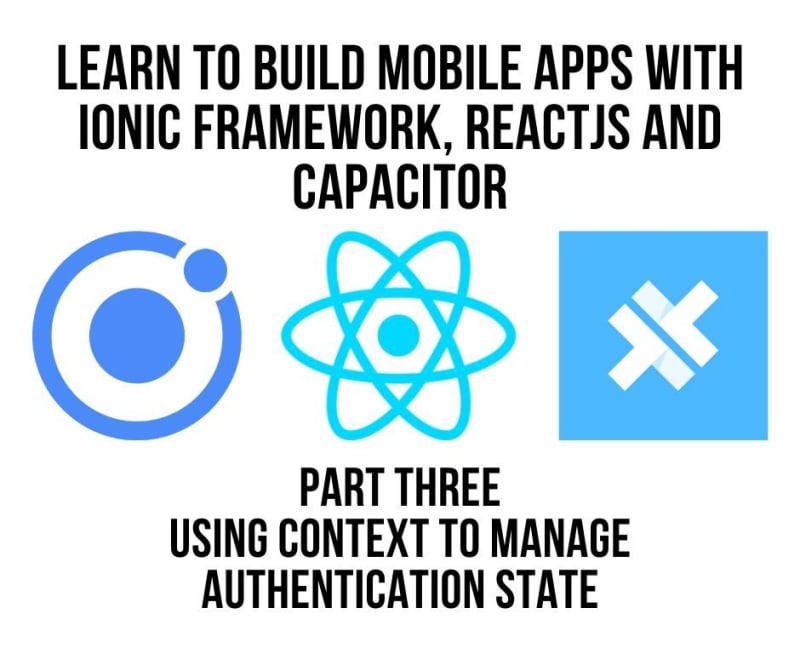Learn to Build Mobile Apps With Ionic Framework, ReactJS and Capacitor : Manage Authentication State using React Context API
Overview
We modify the Ionic Framework ReactJS Two Tab Application from the previous lesson to now have a LoginPage Component.
The LoginPage Component is setup in a separate navigation stack than the navigation stack that supports the Two Tabs. I find this is an easier approach than wrapping each route with a protected function and it just is simpler to visually see what is happening in the application when reading the code.
The application changes the default Navigation Stack using IonicRouter from the Ionic implementation of React Navigation when the authentication state changes. The authentication state in managed in the new context component that we build in this video
const App: React.FC = () => {
const { authValue } = React.useContext(AuthContext);
return (
<IonApp>
{!authValue.authenticated ? (
<IonReactRouter>
<Route path="/login" component={LoginPage} exact={true} />
<Route
path="/"
render={() => <Redirect to="/login" />}
exact={true}
/>
<Route
path="*"
render={() => <Redirect to="/login" />}
exact={true}
/>
</IonReactRouter>
) : (
<IonReactRouter>
<IonTabs>
<IonRouterOutlet>
{/* specify route to each of teh tabs*/}
<Route path="/tab1" component={Tab1} exact={true} />
<Route path="/tab2" component={Tab2} exact={true} />
<Route
path="/tab2/tab-detail"
component={TabDetail}
exact={true}
/>
{/* default route is to tab1 */}
<Route
path="/"
render={() => <Redirect to="/tab1" />}
exact={true}
/>
</IonRouterOutlet>
{/* draw what the tab bar should look like*/}
<IonTabBar slot="bottom">
<IonTabButton tab={"tab1"} href={"/tab1"}>
<IonLabel>{"Tab One"}</IonLabel>
</IonTabButton>
<IonTabButton tab={"tab2"} href={"/tab2"}>
<IonLabel>{"Tab Two"}</IonLabel>
</IonTabButton>
</IonTabBar>
</IonTabs>
</IonReactRouter>
)}
</IonApp>
);
};
We rename the context that we created to AuthContext and we add the authValues and expose functions to login and logout of the application.
Then in the application we access the context values for authentication status, authenticated and we use the functions when we want to login or logout.
export const AuthProvider: React.FC = ({ children }) => {
// the reactive values
const [authValues, setAuthValues] = React.useState<any>({
authenticated: false,
user: null,
});
const login = ({ user, password }: { user: string; password: string }) => {
return new Promise((resolve) => {
if (user === "aaron" && password === "aaron") {
setAuthValues({
authenticated: true,
user: { user: user, id: "aaron-100" },
});
resolve(true);
} else {
resolve(false);
}
});
};
const logout = () => {
setAuthValues({
authenticated: false,
user: null,
});
return Promise.resolve(true);
};
// the store object
let state = {
authValues,
login,
logout,
};
// wrap the application in the provider with the initialized context
return <Context.Provider value={state}>{children}</Context.Provider>;
};
The Video
Other Videos In The Series
Part One : Here we start with the famous two tab application and walk through the structure of the application how to set up the routes for the tabs also how you implement a detail screen for a specific tab.
[VIDEO] https://youtu.be/LGyqrZ85RDk
Part Two: Managing State Between Two Tabs using ReactJS Context API: we just walkthrough a simple solution where we change the value in one tab and use the context api to manage the value, and provide access to the value in different tabs in the application.
[VIDEO] https://youtu.be/DiCzp5kIcP4
Important Links
- Ionic ReactJS Playlist View Videos
React Documentation Referenced







Latest comments (2)
i try to keep it going!! Thanks for taking the time to leave a comment
.,,mmm